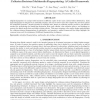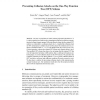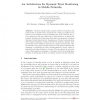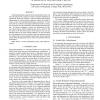122
click to vote
SSWMC
2004
15 years 1 months ago
2004
Digital fingerprints are unique labels inserted in different copies of the same content before distribution. Each digital fingerprint is assigned to an intended recipient, and can...
121
Voted
ICCSA
2007
Springer
15 years 6 months ago
2007
Springer
In our recent study, we have presented an approach for tracing illegal users in content distribution networks using watermarking and fingerprinting techniques [1][2]. In this paper...
123
Voted
EUC
2007
Springer
15 years 6 months ago
2007
Springer
Abstract. Random key pre-distribution schemes are vulnerable to collusion attacks. In this paper, we propose a new key management scheme for ubiquitous heterogeneous sensor network...
ACNS
2007
Springer
15 years 6 months ago
2007
Springer
The one-way function tree (OFT) scheme proposed by Balenson et. al is widely regarded as an efficient key management solution for multicast communication in large dynamic groups. ...
106
Voted
OTM
2009
Springer
15 years 7 months ago
2009
Springer
Collusion attacks remain a major problem of reputation and trust models, in mobile ad hoc networks. By covering up malicious behaviour of one another from the remaining part of the...
98
Voted
ICASSP
2009
IEEE
15 years 7 months ago
2009
IEEE
— An anti-collusion fingerprinting system is developed to protect media files against time-varying collusion attacks based on the scalar Costa scheme (SCS) and colluder weight ...
ICIP
2005
IEEE
16 years 2 months ago
2005
IEEE
A powerful class of attacks in multimedia fingerprinting is known as collusion attacks, where a clique of colluders, each having a copy of the same multimedia content with differe...
97
Voted
ICIP
2006
IEEE
16 years 2 months ago
2006
IEEE
During collusion attacks against multimedia forensics, an important issue that colluders need to address is the fairness of the attack, i.e., whether all colluders take the same r...
104
click to vote
ICIP
2006
IEEE
16 years 2 months ago
2006
IEEE
Digital fingerprinting uniquely labels each distributed copy with user's ID and provides a proactive means to track the distribution of multimedia. Multi-user collusion is a ...





